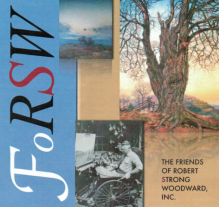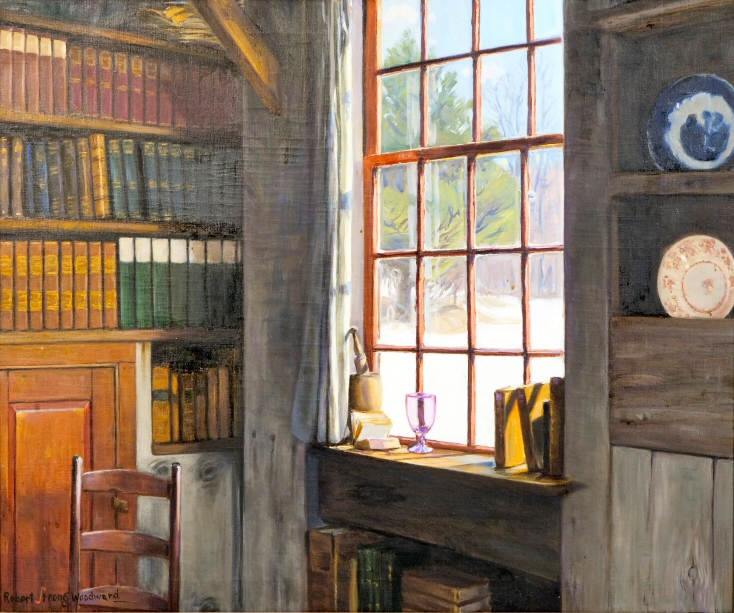Quick Reference
1934-'37
Oil on Canvas
Interior Home
Still Life
Unknown
Los Angeles Art Association, 1937
Mrs. Josephine Everett
See Mrs. Everett's page
Featured Artwork: Gray Room in Sunlight
RSW's Diary Comments

 An early KodaChrome photograph of the book
An early KodaChrome photograph of the book
corner inside the the old Boehmer Mill RSW called
"the little shop" taken by F. Earl Williams in late 1930s.
This photo might just be the perspective RSW used
for this painting. He loved that quaint book corner
and note how gray the interior boards are. No other
place RSW owned other than Redgate had such a look
and Regate burned in 1922 with no pics of its interior.
 There is no diary comments for this painting. Many of the paintings Woodward
sent to Mrs. Henry Everett often were excluded from the artist's painting
diary. We have a theory as to why and it is twofold. First is, when Woodward made a painting that was special or
had some success, he often made her a version of the scene and perhaps he could not remember all of the times he did
this or feared he would mix up which painting was which despite naming them slightly different names. Second is the
possibility he did not want a record of multiple versions of the same painting. He did a similar thing with his Los
Angeles friend, agent, and interior designer, Harold Grieve,
taking advantage of his connections to both coast to sell two paintings of what is in many cases- the same scene.
Keep in mind that Woodward solely made his living from painting a rarity in any time period. Yet, he also did not
have a lot of other options to earn a living beyond art.. We do not judge him for the practice. It does illustrate
his business acumen.
There is no diary comments for this painting. Many of the paintings Woodward
sent to Mrs. Henry Everett often were excluded from the artist's painting
diary. We have a theory as to why and it is twofold. First is, when Woodward made a painting that was special or
had some success, he often made her a version of the scene and perhaps he could not remember all of the times he did
this or feared he would mix up which painting was which despite naming them slightly different names. Second is the
possibility he did not want a record of multiple versions of the same painting. He did a similar thing with his Los
Angeles friend, agent, and interior designer, Harold Grieve,
taking advantage of his connections to both coast to sell two paintings of what is in many cases- the same scene.
Keep in mind that Woodward solely made his living from painting a rarity in any time period. Yet, he also did not
have a lot of other options to earn a living beyond art.. We do not judge him for the practice. It does illustrate
his business acumen.
Editor's Note:
We do not know what the subject of this painting is, however, from its name we believe it is
probably an interior of the Old Boehmer's Mill he once affectionately called his "Folly." He purchased the place in
1931 while living on the property adjacent to it, The
Hiram Woodward Farm. He never used the building for anything in particular (thus the term folly) but we believe
he intended to convert it to a showroom for customers to visit and purchase his work without catching him unprepared
inside his private studio. The man was very self-conscious about anyone seeing him in anyway less than dapper and
well put together which is very difficult when working. It is also why we believe he more frequently referred to it
as "the Little Shop," suggesting his intent. Unfortunately, that never worked out because in July of 1934, lightning
struck the Hiram Woodward Place burning most of it to the ground.
Woodward kept the old mill after he
purchased and moved into the Southwick Place. Later
RSW's hopes would be that Dr. Mark would use it for
his music shop but that also never materialized as Doc turned his sights to medicine. We do not think either man
considered the place for Dr. Mark's country doctor practice, however, Woodward left the beloved folly to his dear
cousin Florence who ran her antique business from
the property into the 1980s until she retired. Dr. Mark of course converted the carriage house on the Southwick
property into his medical practice.
Additional Notes
There is absolutely no certainty that this painting is an interior of the Boehmer Mill. We are simply going by the
description the painting's name provides. We trust it is an interior and it could equally be a barn interior or some
other building. Woodward did paint interiors of other peoples' homes, however, two where exclusively part of his study
of the Keach Farm and the other two were by commission. Nonethe less still, when considering his own
properties, neither the Hiram nor Southwick studios had any gray boards. Both studios were quite warm in their wood tones.
The old mill was another story. Despite being just a little older than Woodward's Southwick studio (formerly a blacksmith
shop), the three images we have of its interior, the Kodachrome picture above the painting to the left, and the image
below show clearly dry, aged, gray wood. What's more is that both photos and painting feature the same local- the much
admired book corner and window from slightly different perspectives. It truly is idyllic, as well as very early American
(gray being the most common American spelling) and indicates to us that if it is not this subject. It one this is very
similar, like maybe a tack room of a barn or even a sugarhouse. Those are two subjects he was painting in the late 1920s
and early 1930s on a regular basis. For instance, Woodward made a number of painting of the Roscoe sugarhouse, including
its interior, but we do not have any images of them.

 Another picture of the Book Corner with
Another picture of the Book Corner with
what we believe is a skaters lamp on the sill.
Complicating our theory even more is that in his diary comments for The Book Corner claim that it was, "The first picture I made in the old gray shop..." and some simple deduction tells you that 1935 is before 1943.
Diary Comments from The Book Corner:
"Upright 1943. The first picture I made in the old gray shop, done in the late winter of 1943. Rich in the quaint atmosphere of the dear place. Sold, March, 1944, to the Grand Central Art Galleries for their 1944 Founders' Show."
Nonetheless, Woodward's memories of these things are not very reliable. We point out above that this prized painting has no diary comment. This painting hung at the prestigious Los Angeles Art Association's 1937 "Loan Exhibition" where is hung with the likes of Bellows, Whistler, Henri, Cassat, Blakelock, Inness, Lucioni, Fuller, Kent and Ryder. He even has the event's program in his private papers! How do you not write a diary comment about a painting (1) owned by Everett, (2) it exhibited at a show he has the program of and, that will later be given to the Pasadena Museum of Art as part of Everett's Collection there?

 The cover for the Los Angeles Art Ass-
The cover for the Los Angeles Art Ass-
ociation's program for its 1937 "Loan Exhibi-
tion," featuring paintings lent by collectors.
We are asking these questions rhetorically. Until we actually locate the painting (the Pasadena MoA merged with
another museum and evolved into the Norton Simon Museum which can be seen during the broadcast of the Tournament of Roses
Parade). Its whereabouts are currently unknown and thus its subject is also a mystery.
Adding to our argument, which
is not going great so far, is the fact that the painting, The Book Corner, was sold to the Grand Central Art Galleries'
Founders' show which is the association's annual fundraising event where it buys the best of the best of its members art
work and re-sells it for a profit. It is an honor to have your work purchased for the event, indicating how Woodward felt
about its subject. It was important to him. We made a similar argument for
Unnamed: A Hill Road; Heath when Woodward made no mention of previously painting an earlier painting from the same location
in his painting diary for the award winning A Hill Road.
Woodward
uses both spellings of Gray (American spelling) and Grey (British spelling). The Chicago Manual of Style says it is okay to
use both spellings in a manuscript so long as its meaning remains consistent. We cannot say for sure if the artist is following
this practice or not because we have not discovered a distinct pattern in its usage of the spelling one way or another.
Bonus Material
This painting was sold to Mrs. Henry Everett for her famous collection. It was later willed to the Pasadena Art Museum which sold it at a Sotherby's auction in Los Angeles on March 17, 1980, sale # 272, lot 324 to an unknown buyer.
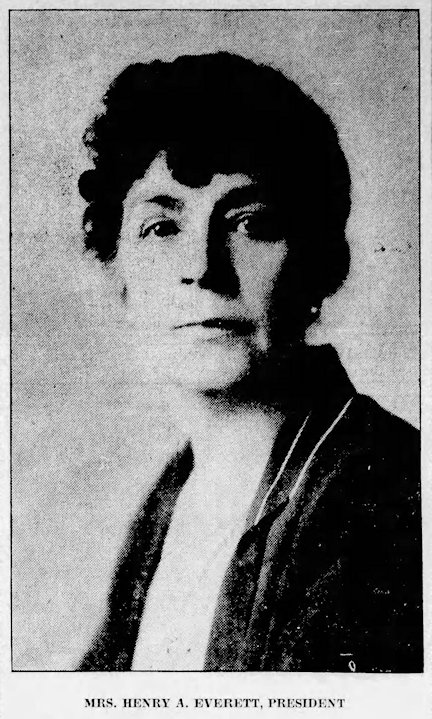
 The only photograph of Mrs. Everett
The only photograph of Mrs. Everett
we could find after and exhaustive search.
Published in the Pasedena Evening Post
June 22, 1928. She is 62 year old in the clip.
Mrs. Everett was one of three women to strongly support and advocate for Woodward. She is one of two who met and knew him as a young adult, prior to him becoming a professional artist. Woodward's father Orion, a real estate developer, made his mark first by working for an Ohio developers, the Briggs Company, that later moved to Los Angeles, CA to work on numerous projects.
The Everetts, key in the development business through interbureau transportation and power (trollys) first in Cleveland, OH and later
took residence in Pasadena, CA. She is responsible for putting Woodward in the Los Angeles Art Museum twice, and divided her paintings
between the Pasadena Museum of Art and the San Diego Museum of Art. The two were close enough for Woodward to visit with her
at her hotel when visiting New York City for the annual Watercolor Society Association's annual Spring show. Woodward was a member
of the society.
While relatively speaking, Mrs. Everett is mostly unknown, however, she was a great patron of the arts and is
credited with writing the check, that paid for the land that the famed Hollywood Bowl sits to this day.
To read more about Mrs. Everett, please Click Here!


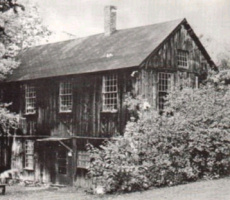
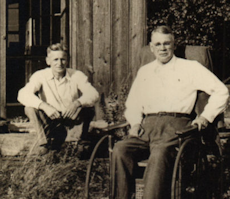 RSW friend, educator, and amateur photographer
RSW friend, educator, and amateur photographer 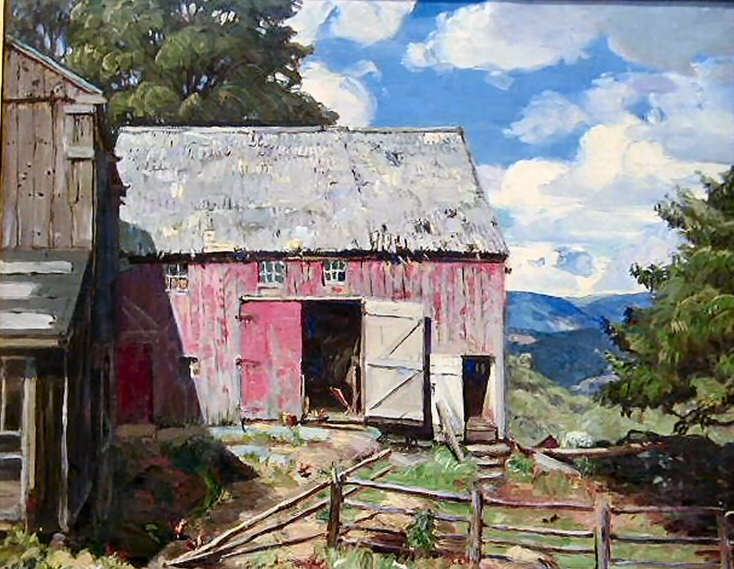
.png)
